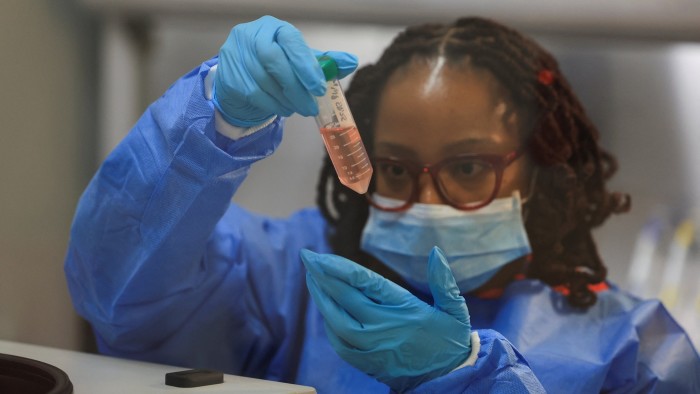Unlock the Editor’s Digest for free
Roula Khalaf, Editor of the FT, selects her favourite stories in this weekly newsletter.
Funding cuts by the US and other big donor countries threaten to undo a successful 22-year campaign to combat HIV/Aids, new research has warned.
The proposed spending curbs could cause up to 10.8mn additional infections and 2.9mn deaths by 2030, with sub-Saharan African countries and marginalised groups most at risk, says the study published in The Lancet HIV journal late on Wednesday.
The modelling study underscores the potential impact of sweeping US aid cuts by President Donald Trump’s administration, together with reductions by European countries facing demands to increase military spending.
HIV/Aids programmes are under particular pressure because of the central role played by the President’s Emergency Plan for Aids Relief (Pepfar) initiative launched by Trump’s predecessor and fellow Republican George W Bush in 2003.
“Our study indicates new HIV infections and deaths could surge back to levels not seen since the early 2000s if severe funding cuts for HIV are implemented,” said Rowan Martin-Hughes, a co-author of the study and senior research officer at Australia’s Burnet Institute for medical research.
“This could undo the work of what is widely seen as one of the great public health success stories of the past quarter-century — largely funded by the US.”
The research used a mathematical model across 26 countries to estimate the potential impact of various spending reduction scenarios for the top five donor countries that account for 90 per cent of HIV funding. The US contributes almost three-quarters of funding, with the UK, France, Germany and the Netherlands providing more than 18 per cent between them.
The result could lead to between 4.4mn and 10.8mn additional new HIV infections by 2030 in low and middle-income countries that receive international financial assistance, the study found. The cuts could cause between 770,000 and 2.9mn HIV-related deaths in children and adults over the same time period.
HIV, the human immunodeficiency virus, leads to the potentially fatal acquired immunodeficiency syndrome (Aids) at advanced stages of infection.
Aid funding has helped trigger a sharp drop in global rates of HIV infections and deaths related to the virus, which has killed more than 40mn people since 1980. New HIV infection rates in sub-Saharan African countries have plunged more than half since their 1995 peak, according to a study published in November.
The latest study comes after technology billionaire Elon Musk’s so-called Department of Government Efficiency dismantled the US Agency for International Development.
While the Trump administration has issued a waiver to keep Pepfar funding flowing with stricter conditions, many observers report a severe disruption to HIV/Aids work in eastern and Southern Africa, as well as Nigeria, the continent’s most populous country.
Kate Knopf, a Nairobi-based consultant who headed USAID’s Africa bureau under George W Bush, said even the lower ends of modelled estimates were “horrifying,” adding: “We still don’t have accurate or full lists of what has been terminated and what has been spared.”
USAID has sent Congress a 281-page spreadsheet outlining the projects it planned to cut, according to a New York Times report on Wednesday. Some HIV medication grants would be maintained.
The rapid nature of the cuts has had political reverberations. South Africa has twice delayed the adoption of a national budget, in part because the government is grappling with the trade-offs required to finance a R800mn ($44mn) hole left by the withdrawal of USAID.
Crucial health trials — including a US-funded HIV vaccine trial being run with scientists from eight countries on the continent — are now on hold in South Africa.
On the ground, workers said the impact continued to be severe. Ling Sheperd, an activist and director at the Triangle Project, which provides healthcare in Western Cape province, said there had been “a decline in the number of people able to attend their appointments, as many struggle with transport costs or are forced to prioritise other urgent needs”.
She added: “These cuts don’t just affect numbers on a budget sheet, they impact real people who rely on these services for their health and dignity.”
Data visualisation by Steven Bernard
Read the full article here

